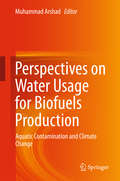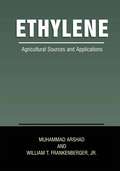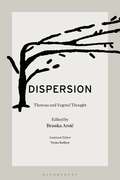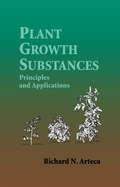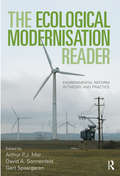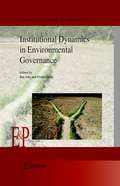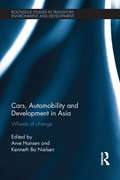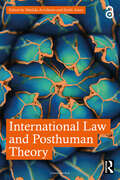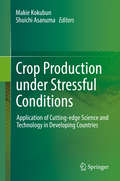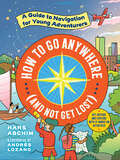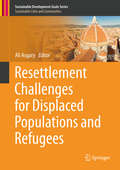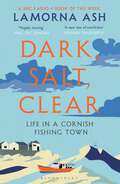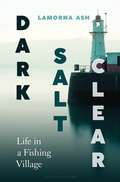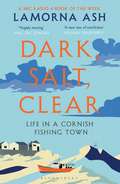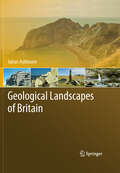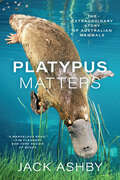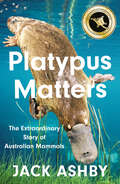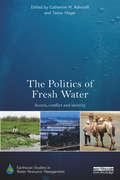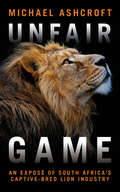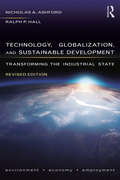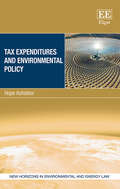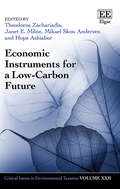- Table View
- List View
Perspectives on Water Usage for Biofuels Production: Aquatic Contamination and Climate Change
by Muhammad ArshadThe book integrates the fundamental factors that determine current and future impacts of biofuels production on water supply and demand in the context of climatic changes. The effects of biofuels production on ground water quality with increasing water scarcity are examined, and the utilization of water sources in the commercial scale production of biofuels are sketched, covering the complete route from growing of crops to biorefinery. Biofuel's chemical composition, characteristics and uses as fuel in terms of water consumption are also investigated. Overall, the diversity of biomass, various technological approaches and microbial contribution are reviewed.Learning objectives on this topic are presented by means of a series of tables and figures in order to guide both professionals and students. The present manuscript deals with biofuel and bioenergy courses and is therefore invaluable to students. The book provides thorough coverage of all industrial aspects of biofuels production, including impacts of climate change and water availability. It will play vital role for industry employees involved in product development, production management, quality management and helpful source to those studying for professional qualification. Academics involved in teaching elements of the subject and persons involved in an environment regulatory capacity would be able to take advantage from this book.
Ethylene: Agricultural Sources and Applications
by Muhammad Arshad William T. Frankenberger Jr.With an ever-increasing demand for more food supply, agricultural scientists will have to search for new ways and technologies to promote food production. In recent decades, plant growth regulators (PGRs) have made great strides in promoting plant growth and development. PGRs are organic compounds which have the ability to dramatically affect physiological plant processes when present in extremely low concentrations (in the range of micro-to picograms). Although all higher plants have the ability to synthesize PGRs endogenously, they do respond to the exogenous sources most likely due to not having the capacity to synthesize sufficient endogenous phytohormones for optimal growth and development under given climatic and environmental conditions. In recent years, PGRs have established their position as a new generation of agrochemicals after pesticides, insecticides and herbicides. Interest in the commercial use of PGRs for improving plant growth and crop yields is also increasing because of their non-polluting nature. The use of PGRs in the post-harvest technology is well established and many new breakthroughs have recently been revealed.
Dispersion: Thoreau and Vegetal Thought
by Branka ArsićPlants are silent, still, or move slowly; we do not have the sense that they accompany us, or even perceive us. But is there something that plants are telling us? Is there something about how they live and connect, how they relate to the world and other plants that can teach us about ecological thinking, about ethics and politics? Grounded in Thoreau's ecology and in contemporary plant studies, Dispersion: Thoreau and Vegetal Thought offers answers to those questions by pondering such concepts as co-dependence, the continuity of life forms, relationality, cohabitation, porousness, fragility, the openness of beings to incessant modification by other beings and phenomena, patience, waiting, slowness and receptivity.
Plant Growth Substances: Principles and Applications
by Richard N. ArtecaIn a convenient, single-source reference, this book examines plant growth substances and their relationship to a wide range of physiological processes, ranging from seed germination through the death of the plant. If offers a clear illustration of the pragmatic uses of plant substances in agriculture and demonstrates how basic laboratory research has translated into increased production and profit for the grower. This work begins by building a solid foundation in the subject, which contains historical aspects and fundamental concepts, and provides a methodology for extraction, purification, and quantification of plant growth substances. This forms the basis for understanding the ensuing chapters that explore the many processes involving plant growth substances, including: * seed germination * seedling growth * rooting * dormancy * juvenility * maturity * senescence * flowering * abscission * fruit set * fruit growth * fruit development * premature drop * ripening * promotion of fruit drop * tuberization * photsynthesis * weed control. Providing a detailed examination of plant growth substances and their relationships to specific physiological plant processes, Plant Growth Substances gives students, researchers, and professionals a much needed reference.
The Ecological Modernisation Reader: Environmental Reform in Theory and Practice
by Arthur P.J. MolStructural environmental reform by firms and industries, governmental and intergovernmental agencies, non-governmental organisations (NGOs), and others is a worldwide phenomenon and the focus of this definitive collection. Includes a comprehensive introduction to and overview of Ecological Modernisation Theory; original, state-of-the-art review essays by distinguished international scholars; a selection of the best published works and debates from a quarter-century of related social science scholarship; an emphasis on environmental issues in Asian and other emerging economies; and an agenda for continued scholarship, policymaking, and practice. Accessible to students, policymakers, professionals, executives, and others interested in deeply understanding contemporary environmental issues and taking effective action for environmental solutions. Rigorous and sophisticated for use in graduate and advanced studies. Appropriate for courses in Sociology, Political Science, Policy Studies, Geography, Environmental Studies, Environmental Planning, Business, Economics, Asian Studies, Development Studies, and other fields.
Institutional Dynamics in Environmental Governance (Environment & Policy #47)
by Bas Arts Pieter LeroyThis book presents fresh analyses of a number of well-known cases, but does so from one comprehensive view, the so-called policy arrangement approach. Cases discussed range over organic farming, integrated water management, nature policy, cultural heritage policy, integrated region-oriented policy, corporate environmental management and target group policy, always in search of the commonality of experience and conclusions to be drawn in understanding the past and in formulating future perspectives.
Cars, Automobility and Development in Asia: Wheels of change (Routledge Studies in Transport, Environment and Development)
by Arve Hansen and Kenneth Bo NielsenCars, Automobility and Development in Asia explores the nexus between automobility and development in a pan-Asian comparative perspective. The book seeks to integrate the policies, production forms, consumption preferences and symbolism implicated in emerging Asian automobilities. Using empirically rich and grounded analyses of both comparative and single-country case studies, the authors chart new approaches to studying automobility and development in emerging Asia.
International Law and Posthuman Theory
by Matilda Arvidsson Emily JonesAssembling a series of voices from across the field, this book demonstrates how posthuman theory can be employed to better understand and tackle some of the challenges faced by contemporary international law.With the vast environmental devastation being caused by climate change, the increasing use of artificial intelligence by international legal actors and the need for international law to face up to its colonial past, international law needs to change. But in regulating and preserving a stable global order in which states act as its main subjects, the traditional sources of international law – international legal statutes, customary international law, historical precedents and general principles of law – create a framework that slows down its capacity to act on contemporary challenges, and to imagine futures yet to come. In response, this collection maintains that posthuman theory can be used to better address the challenges faced by contemporary international law. Covering a wide array of contemporary topics – including environmental law, the law of the sea, colonialism, human rights, conflict and the impact of science and technology – it is the first book to bring new and emerging research on posthuman theory and international law together into one volume.This book’s posthuman engagement with central international legal debates, prefaced by the leading scholar in the field of posthuman theory, provides a perfect resource for students and scholars in international law, as well as critical and socio-legal theorists and others with interests in posthuman thought, technology, colonialism and ecology.Chapters 1, 9 and 11 of this book is freely available as a downloadable Open Access PDF at http://www.taylorfrancis.com under a Creative Commons Attribution-Non Commercial-No Derivatives (CC-BY-NC-ND) 4.0 license.
Crop Production under Stressful Conditions: Application of Cutting-edge Science and Technology in Developing Countries
by Shuichi Asanuma Makie KokubunThis book presents field studies on crop production in developing countries such as Vietnam, Kenya, Namibia, Colombia, Afghanistan and Sudan. Further, it examines the achievements of SATREPS, a development assistance program sponsored by the Japanese government that promotes international joint research to address these global issues. In this context, multidisciplinary research teams consisting of breeders, physiologists, soil scientists, agronomists, and other scientists related to agricultural development worked together to tackle the challenges involved in enhancing the capacity of crop production in the respective regions. In addition to presenting novel scientific findings, this book highlights practical field studies that verify the effectiveness of the scientific findings in actual environments. The achievements will help to improve crop production worldwide, and the lessons learnt will be useful in re-designing strategies to address global issues in crop production, particularly in developing regions. Lastly, the outcomes discussed will be useful to policymakers and professionals engaged in crop production and food security in developing countries, as well as researchers and students.
How to Go Anywhere (and Not Get Lost): A Guide to Navigation for Young Adventurers
by Hans AschimA fun, fully illustrated history of navigation, from the earliest Polynesian star navigators to modern-day GPS - complete with hands-on activities to demonstrate the various tools and techniques.
Fire Behavior and Fire Protection in Timber Buildings (Springer Series in Wood Science)
by Roza Aseeva Boris Serkov Andrey SivenkovThis volume describes fire behavior and fire protection of timbers in outdoors and indoors application mainly in construction industry. The Authors’ novel approach considers the relationship between various species and age of timbers and its fire behavior at different thermal and fire loads. Quantitative data of ignition speed and flame propagation as well as generation of heat, smoke and toxic products are discussed. Analysis of fire resistance of various types of building materials based on timber of different species as well as the novel data on the effect of natural and accelerated aging of timbers on its fire behavior are discussed. The main practical methods of fire protection of new and ancient timber buildings and structures to increase its fire resistance are considered. The book should be useful for a wide range of readers: chemists, physicists, material scientists, architects, engineers, constructors and restorers.
Resettlement Challenges for Displaced Populations and Refugees (Sustainable Development Goals Series)
by Ali AsgaryThe main focus of this book is to help better understand the multidimensionality and complexity of population displacement and the role that reconstruction and recovery knowledge and practice play in this regard. According to the UN Refugee Agency (UNHCR), the total number of people forcibly displaced due to wars and conflicts, disasters, and climate change worldwide, exceeded 66 million in 2016. Many of these displaced populations may never be able to go back and rebuild their houses, communities, and businesses.This text brings together recovery and reconstruction professionals, researchers, and policy makers to examine how displaced populations can rebuild their lives in new locations and recover from disasters that have impacted their livelihoods, and communities. This book provides readers with an understanding of how disaster recovery and reconstruction knowledge and practice can contribute to the recovery and reconstruction of displaced and refugee populations. This book will appeal to students, researchers, and professionals working in the field.
Dark, Salt, Clear: Life in a Cornish Fishing Town
by Lamorna AshA BBC RADIO 4 BOOK OF THE WEEK'Marks the birth of a new star of non-fiction' William DalrympleA captivating, lyrical and deeply discerning portrait of life in the Cornish town of Newlyn, the largest working fishing port in Britain, from a brilliant debut writerThere is the Cornwall Lamorna Ash knew as a child – the idyllic, folklore-rich place where she spent her summer holidays. Then there is the Cornwall she discovers when, feeling increasingly dislocated in London, she moves to Newlyn, a fishing town near Land's End. This Cornwall is messier and harder; it doesn't seem like a place that would welcome strangers. Before long, however, Lamorna finds herself on a week-long trawler trip with a crew of local fishermen, afforded a rare glimpse into their world, their warmth and their humour. Out on the water, miles from the coast, she learns how fishing requires you to confront who you are and what it is that tethers you to the land. But she also realises that this proud and compassionate community, sustained and defined by the sea for centuries, is under threat, living in the lengthening shadow cast by globalisation. An evocative journey of personal discovery replete with the poetry and deep history of our fishing communities, Dark, Salt, Clear confirms Lamorna Ash as a strikingly original new voice.
Dark, Salt, Clear: The Life of a Fishing Town
by Lamorna AshFrom an adventurous and discerning new voice reminiscent of Robert Macfarlane, a captivating portrait of a community eking out its living in a coastal landscape as stark and storied as it is beautiful.Before arriving in Newlyn, a Cornish fishing village at the end of the railway line, Lamorna Ash was told that no fisherman would want a girl joining an expedition. Weeks later, the only female on board a trawler called the Filadelfia, she is heading out to sea with the dome of the sky above and the black waves below.Newlyn is a town of dramatic cliffs, crashing tides, and hardcore career fishermen-complex and difficult heroes who slowly open up to Ash about their lives and frustrations, first in the condensed space of the boat, and then in the rough pubs ashore. Determined to know the community on its own terms, Ash lodges in a spare room by the harbor and lets the village wash over her in all of its clamoring unruliness, thumping machinery, and tangled nets-its history, dialect, and centuries-old industry.Moving between Ash's surprising, transformational journey aboard the Filadelfia and her astute observations of Newlyn's landscape and people, Dark, Salt, Clear is an assured work of indelible characters and a multilayered travelogue through a landscape both lovely and merciless. Ash's adventurous glint, her delicate observations, and her willingness to get under the skin of a place call to mind the work of Annie Dillard, Barry Lopez, and Robert Macfarlane. This is an evocative journey and a fiercely auspicious debut.
Dark, Salt, Clear: Life in a Cornish Fishing Town
by Lamorna AshA BBC RADIO 4 BOOK OF THE WEEKSHORTLISTED FOR THE WAINWRIGHT PRIZE A SUNDAY TIMES AND FINANCIAL TIMES BOOK OF THE YEAR 'Marks the birth of a new star of non-fiction' William Dalrymple'A beautiful account of immersion in an alien world' Philip Marsden, GuardianThere is the Cornwall Lamorna Ash knew as a child – the idyllic, folklore-rich place where she spent her summer holidays. Then there is the Cornwall she discovers when, feeling increasingly dislocated in London, she moves to Newlyn, a fishing town near Land's End. This Cornwall is messier and harder; it doesn't seem like a place that would welcome strangers. But before long, Lamorna finds herself on a week-long trawler trip with a crew of local fishermen, afforded a rare glimpse into their world, their warmth and their humour. Out on the water, miles from the coast, she learns how fishing requires you to confront who you are and what it is that tethers you to the land. Dark, Salt, Clear is a bracing journey of discovery and a captivating portrait of a community sustained and defined by the sea for centuries.
Geological Landscapes of Britain
by Julian AshbournThis book discusses the geological history of Britain from the early geological formation of the British Isles, through to the variety of currently visible rock formations and ensuing natural landscapes. It is presented as an accessible narrative which may be utilised in a variety of educational contexts, or simply enjoyed as an holistic overview of the subject. It additionally provides an important visual record of British geology in the 21st century via a portfolio of high quality, scientifically accurate photographs, which are themselves part of a larger collection, being developed to become the definitive image library for British geoscience. In addition, the book provides an insight into the relationship between the geology of Britain and how early settlers interacted with the landscape throughout Mesolithic and Neolithic times. It is a book which serves equally as a scientific reference, an introduction to the subject of British geology and, no doubt, as an edition which will remain a pleasure to own in its own right.
Platypus Matters: The Extraordinary Story of Australian Mammals
by Jack AshbyScientifically informed and funny, a firsthand account of Australia’s wonderfully unique mammals—and how our perceptions impact their future. Think of a platypus: They lay eggs (that hatch into so-called platypups), produce milk without nipples and venom without fangs, and can detect electricity. Or a wombat: Their teeth never stop growing, they poop cubes, and they defend themselves with reinforced rears. And what about antechinuses—tiny marsupial carnivores whose males don’t see their first birthday, as their frenzied sex lives take so much energy that their immune systems fail? Platypuses, possums, wombats, echidnas, devils, kangaroos, quolls, dibblers, dunnarts, kowaris: Australia has some truly astonishing mammals, with incredible, unfamiliar features. But how does the world regard these creatures? And what does that mean for their conservation? In Platypus Matters, naturalist Jack Ashby shares his love for these often-misunderstood animals. Informed by his own experiences meeting living marsupials and egg-laying mammals during fieldwork in Tasmania and mainland Australia, as well as his work with thousands of zoological specimens collected for museums over the last two-hundred-plus years, Ashby’s tale not only explains historical mysteries and debunks myths (especially about the platypus), but also reveals the toll these myths can take. Ashby makes clear that calling these animals “weird” or “primitive”—or incorrectly implying that Australia is an “evolutionary backwater,” a perception that can be traced back to the country’s colonial history—has undermined conservation: Australia now has the worst mammal extinction rate of any place on Earth. Important, timely, and written with humor and wisdom by a scientist and self-described platypus nerd, this celebration of Australian wildlife will open eyes and change minds about how we contemplate and interact with the natural world—everywhere.
Platypus Matters: The Extraordinary Story of Australian Mammals
by Jack AshbyScientifically informed and funny, a firsthand account of Australia’s wonderfully unique mammals—and how our perceptions impact their future. Think of a platypus: They lay eggs (that hatch into so-called platypups), produce milk without nipples and venom without fangs, and can detect electricity. Or a wombat: Their teeth never stop growing, they poop cubes, and they defend themselves with reinforced rears. And what about antechinuses—tiny marsupial carnivores whose males don’t see their first birthday, as their frenzied sex lives take so much energy that their immune systems fail? Platypuses, possums, wombats, echidnas, devils, kangaroos, quolls, dibblers, dunnarts, kowaris: Australia has some truly astonishing mammals, with incredible, unfamiliar features. But how does the world regard these creatures? And what does that mean for their conservation? In Platypus Matters, naturalist Jack Ashby shares his love for these often-misunderstood animals. Informed by his own experiences meeting living marsupials and egg-laying mammals during fieldwork in Tasmania and mainland Australia, as well as his work with thousands of zoological specimens collected for museums over the last two-hundred-plus years, Ashby’s tale not only explains historical mysteries and debunks myths (especially about the platypus), but also reveals the toll these myths can take. Ashby makes clear that calling these animals “weird” or “primitive”—or incorrectly implying that Australia is an “evolutionary backwater,” a perception that can be traced back to the country’s colonial history—has undermined conservation: Australia now has the worst mammal extinction rate of any place on Earth. Important, timely, and written with humor and wisdom by a scientist and self-described platypus nerd, this celebration of Australian wildlife will open eyes and change minds about how we contemplate and interact with the natural world—everywhere.
Platypus Matters: The Extraordinary Story Of Australian Mammals
by Jack AshbyA compelling, funny, first-hand account of Australia's wonderfully unique mammals and how our perceptions impact their future.
The Politics of Fresh Water: Access, conflict and identity (Earthscan Studies in Water Resource Management)
by Catherine M. Ashcraft Tamar MayerWater scarcity is not simply the result of what nature has to offer but always involves power relations and political decisions. This volume discusses the politics of the freshwater crisis, specifically how access to water is determined in different regions and historical periods, how conflict is constructed and managed, and how identity and efforts to control water systems, through development, technologies, and institutions, shape one another. The book analyzes responses to the water crisis as efforts to mitigate water insecurity and as expressions of collective identity that legitimate, resist, or seek to transform existing inequalities. The chapters focus on different processes that contribute to freshwater scarcity, including land use decisions, pollution, privatization, damming, climate change, discrimination, water management institutions and technology. Case studies are included from North and South America, Africa, Asia, Europe and New Zealand.
The Politics of Fresh Water: Access, conflict and identity (Earthscan Studies in Water Resource Management)
by Catherine M. Ashcraft Tamar MayerWater scarcity is not simply the result of what nature has to offer but always involves power relations and political decisions. This volume discusses the politics of the freshwater crisis, specifically how access to water is determined in different regions and historical periods, how conflict is constructed and managed, and how identity and efforts to control water systems, through development, technologies, and institutions, shape one another. The book analyzes responses to the water crisis as efforts to mitigate water insecurity and as expressions of collective identity that legitimate, resist, or seek to transform existing inequalities. The chapters focus on different processes that contribute to freshwater scarcity, including land use decisions, pollution, privatization, damming, climate change, discrimination, water management institutions and technology. Case studies are included from North and South America, Africa, Asia, Europe and New Zealand.
Unfair Game: An exposé of South Africa's captive-bred lion industry
by Michael AshcroftIn April 2019 Lord Ashcroft published the results of his year-long investigation into South Africa’s captive-bred lion industry. Over eleven pages of a single edition of the Mail on Sunday he showed why this sickening trade, which involves appalling cruelty to the ‘King of the Savannah’ from birth to death, has become a stain on the country.Unfair Game, to be published in June 2020, features the shocking results of a new inquiry Lord Ashcroft has conducted into South Africa’s lion business. In the book, he shows how tourists are unwittingly being used to support the abuse of lions; he details how lions are being tranquilised and then hunted in enclosed spaces; he urges the British government to ban the import of captive-bred lion trophies; and he demonstrates why Asia’s insatiable appetite for lion bones has become a multimillion-dollar business linked to criminality and corruption, which now underpins South Africa's captive lion industry.
Technology, Globalization, and Sustainable Development: Transforming the Industrial State
by Nicholas A Ashford Ralph P HallTechnology, Globalization, and Sustainable Development offers a unified, transdisciplinary approach for transforming the industrial state in order to promote sustainable development. The authors present a deep analysis of the ways that industrial states – both developed and developing – are currently unsustainable and how economic and social welfare are related to the environment, to public health and safety, and to earning capacity and meaningful and rewarding employment. The authors offer multipurpose solutions to the sustainability challenge that integrate industrial development, employment, technology, environment, national and international law, trade, finance, and public and worker health and safety. The authors present a compelling wake-up call that warns of the collision course set between the current paths of continued growth and inevitable unsustainability in the world today. Offering clear examples and real solutions, this textbook illustrates how the driving forces that are currently promoting unsustainability can be refocused and redesigned to reverse course and improve the state of the world. This book is essential reading for those teaching and studying sustainable development and the critical roles of the economy, employment, and the environment.
Tax Expenditures and Environmental Policy (New Horizons in Environmental and Energy Law series)
by Hope AshiaborThis timely book provides a critical examination of the ways in which tax expenditures can be best used in order to enhance their efficacy as instruments for the implementation of environmental policy. Examining the capacity and limits of tax expenditures in financing environmental policy, Hope Ashiabor considers their use in various contexts and policies in order to clearly establish the common threads as well as any deviations that have emerged. The book outlines how, when used in environmental policy either to provide preferences to certain activities or to address the challenges of environmental degradation, the management of tax expenditures invariably results in unintended consequences that manifest in negative environmental outcomes and economic inefficiencies. It also examines some of the challenges encountered in re-structuring subsidies that have become environmentally harmful. Tax Expenditures and Environmental Policy will be of great interest to students and scholars in both tax and environmental law. It will also offer an essential tool for policy makers and practitioners through its focus on policy design and its doctrinal analysis.
Economic Instruments for a Low-carbon Future (Critical Issues in Environmental Taxation series)
by Hope Ashiabor Janet E. Milne Mikael Skou Andersen Theodoros ZachariadisCritically assessing recent developments in environmental and tax legislation, and in particular low-carbon strategies, this timely book analyses the implementation of market-based instruments for achieving climate stabilisation objectives around the world. Through case studies and broader analysis, international experts examine taxes and subsidies in energy intensive sectors including stationary energy and transport in Europe and South America, and low-carbon strategies in Australia and East Asia. They also address cross-cutting policy issues involving water pollution and biodiversity protection. This work illustrates how economic instruments for a low-carbon transition need to align with other governmental policies and together influence behaviour in multiple domains such as energy, mobility, trade, land use and innovation. Providing a rich economic modelling of environmental fiscal policies, this topical book will be an engaging read for environmental tax scholars and professionals, as well as academics across energy and environmental economics, law and policy. Policy makers and practitioners in energy and climate policy will also benefit from its problem-solving approach.
